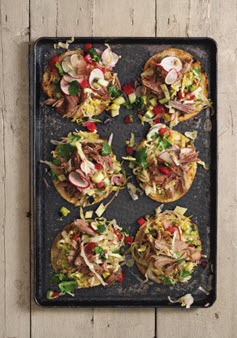Jordan Wright
December 2, 2014
Special to DC Metro Theater Arts

World-renowned chef and international restaurateur Richard Sandoval has penned his latest cookbook, New Latin Flavors – Hot Dishes, Cool Drinks (Stewart, Tabori & Chang) just in time to spice up the holiday season. Most of you will be familiar with his DC Latin/Asian fusion restaurants Zengo, Masa 14, El Centro D. F., but also Ambar with its flavor-forward Balkan dishes, La Sandia in Tyson’s Corner, or the chic, sleek Toro Toro, a churrascaria that opened downtown this April. With thirty-eight successful restaurants worldwide from Dubai to Paris and New York to Mexico, Sandoval’s empire is a testimonial to his delicious contemporary Latin cooking.

Richard Sandoval serving up churrasco at Toro Toro – Photo credit Jordan Wright
In his fifth cookbook Sandoval has given us a collection of 125 inspired recipes that draw from the rich culinary traditions of Mexico, Peru, Venezuela and Argentina. Gorgeous photographs from Saveur photographer Penny De Los Santos grace the pages and highlight the mouth-watering recipes. For the first time Sandoval has tailored a cookbook expressly for the home cook spanning his repertoire of quesadillas, ceviches, arepas and enchiladas plus delicious Latin-inspired cocktails. Think tequila, mescal, cachaça, rum and pisco. Do you feel a party coming on?
Whisk and Quill caught up with Sandoval after he had dodged a blizzard in Denver to get to his DC book launch.
Whisk and Quill – What direction do you think food is going in today?
Sandoval – I think after the recession people’s ways of eating have changed dramatically. The last ten years it went very forward with all these molecular restaurants. I wanted to go retro. You know, back to our roots, back to comfort food and local ingredients, to make people feel comfortable again.
Would you agree that some of the best dishes from the past have been ruined by modernization? Although now I see more chefs returning to the classics but putting their own spin on it.
Absolutely! That’s always been my approach. A lot of my Latin cooking started with my grandmother in her kitchen. I would take dishes, like the mole, and interpret them in my way. I took the roots of these recipes and kept them the way they were meant to be.
What are your favorite ingredients?
I’ve always loved chiles and you’ll always see chiles in my cooking. But as far as cuisines, in the past three or four years I’ve been doing more Peruvian. I love it. And I love Thai food. I’ll be opening a restaurant in mid-January at the new City Center here in DC. It’s called Mango Tree. We brought a chef from Bangkok who worked at one of the other Mango Tree restaurants. I plan to take the roots of their cuisine, tweaking it a little bit as far as my flavor profile and presentation, but leaving the core as it is, maybe just changing the heat level and the balance. I’m incredibly excited. The restaurant already exists in London and Bangkok and Dubai. It’s classic Thai. I’ll just be readjusting it to what I do.
How do you begin to create a fusion dish? Do you start with a single ingredient or do you use your palate’s imagination?
I start with a single dish. The first fusion restaurant I did was Zengo, and Zengo means ‘give and take, back and forth’ in Japanese. It was two chefs, two cultures. First I would do a Latin dish. I hired an Asian chef to work with me and I would give it to him and he would ‘Asianize’ it. Then he would create an Asian dish and give it to me and I would ‘Latinize’ it. It’s two chefs collaborating. It wasn’t just me reinventing Asian, or what I thought it was. This way it made more sense to me.
Why is this book important to you?
When had my first Mexican restaurant twenty years ago, it was doing modern Mexican cuisine – – with more forward thinking. In this book I went retro with more traditional food and more comfort food. It’s very accessible to the home cook. It was very important to me to make sure that when people buy this book, they see it’s about having fun, that it’s not overly complicated where people would look at a recipe and say, ‘Ohmygod, I’ve got to go to Williams Sonoma to get the equipment and will I be able to find the ingredients?’ I wanted to be sure I made it very accessible and very fun.
Who would you most like to dine with living or dead?
I’ve always been very intrigued by Nelson Mandela. How someone can spend so much time in jail and then be able to come out and forgive. Most people would not be able to let go of what happened to them. He just kept moving on with his life and changed his country with his strong spirit and by sharing his ideas.
What if I asked you to name a woman?
Wow! I’ve always liked Shakira! She’s a beautiful woman and a great artist and I love her music.
Maybe she could sing to you.
I don’t think her husband would appreciate that!
We’re fantasizing here.
Okay, I could cook for her and she could sing to me.


